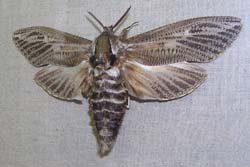The miller moth, which is a mature army cutworm, is a common pest in Colorado. The caterpillar stage of the cutworm is sometimes an important crop pest in the spring.
What do miller moths look like?
These moths are usually gray or brown with two characteristic light spots on each wing. They can be extremely annoying when they get into homes and cars, but they do not breed indoors or eat clothing, and generally die within a few days.
What is the lifecycle of a miller moth?
These pests overwinter as larvae in the soil, primarily in alfalfa and wheat fields in eastern Colorado. In the spring, caterpillars emerge to feed and complete their life cycle. Moths emerge in May or June, with the majority emerging during a very short period. During outbreak years, miller moth flights are typically 5-6 weeks long. However, most nuisance problems are 2-3 weeks. Wet weather and extremely cold winters may kill many of the cutworms.
Do miller moths migrate?
Fall migrations (typically beginning the latter half of September) are smaller and less frequently observed than the spring migration. A possible explanation for the migration is that the moths seek summer flowers which provide nectar (food). Also, the cooler temps of higher elevations are less stressful to the moths.
Why do miller moths live in urban areas?

Experts believe that miller moths get distracted from their normal flight pattern by light at night in urban areas — porch lights, security flood lights and street lamps. Millers avoid daylight and seek shelter before daybreak.
How can I control miller moths in my home?
Insecticides are not effective at controlling these pests. The best controls are to seal any openings in the home, reduce the amount of lights at night or use non-attractive yellow lights. Landscaping considerations can be important to affect the number of millers because some flowering plants are used as shelter by miller moths.
Once inside a home, moths can be controlled with a fly swatter or vacuum cleaner. Keeping a light suspended over a bucket of water during the night also can trap moths.
Remember that these insects are a nuisance, but pose no danger to humans, plants, clothing and fabric. Moths in the home do not feed or lay eggs.
For more information, see the following Colorado State University Extension fact sheet(s).



